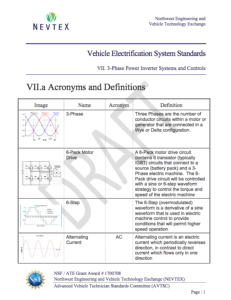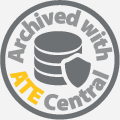Vehicle Electrification Systems Standards: E3-Phase Power Inverter Systems and Controls

Vehicle Electrification Systems Standards Curriculum Description:
The Vehicle Electrification Systems Standards curriculum is provided by the Northwest Engineering and Vehicle Exchange (NEVTEX) and was developed by Central Oregon Community College (COCC) and Rio Hondo College (RHC). COCC and RHC worked together "to develop curriculum and training standards for technicians in hybrid electric vehicle (HEV), electric vehicle (EV), and Fuel Cell (FC) vehicle systems." This curriculum was developed with the intention of addressing industry needs by partnering with industrial and educational representatives to obtain input and assistance to develop:
- new approaches to prepare an advanced technologies workforce,
- licensure procedures and policies to ensure the safety of technicians, their employers, and clients, and
- collaboration between educational and industrial partners in the development of new standards and practices.
The Vehicle Electrification Systems Standards are divided into 11 topics. This section of the standards covers the topic E3-Phase Power Inverter Systems and Controls. The other 10 topics and a Master Acronym and Definition list are available to view separately.
E3-Phase Power Inverter Systems and Controls Description and Contents:
This section of the Standards includes the following supporting document and four lesson plans: VII.a Acronyms and Definitions, VII.b Overview of Power Inverter Systems, VII.c 3-Phase Power Inverter Components, VII.d 3-Phase Power Inverter Operation, and VII.e 3-Phase Power Inverter Diagnostics & Service. The lesson plans include a description, objectives, tools, tasks, and outcomes.
The 12-page acronyms and definitions document includes a number of terms that are used in the included lesson plans. Definitions, acronyms, and images or diagrams are included for the terms.
The 2-page overview of power inverter systems lesson plan includes a task for students " ... to describe the operation of power inverter module in propulsion, regenerative braking, and coasting modes; utilize associated acronyms and definitions when describing each of the aforementioned modes."
The 3-page components lesson plan has students visually identify components within a power inverter module, assemble and reassemble a power inverter module, statically test specified power electronic and electrical components within the power inverter module.
The 3-page operation lesson plan includes three tasks for student. These tasks include describing specific element characteristics of waveforms and determining the stator frequency switching speed, describing the operation of current regulation controls within waveforms and determining the IGBT switching frequency, and describing the difference between a propulsion waveform and a regenerative braking waveform by visual interpretation.
About this Resource


Comments